Maeldune - Light on Maldon's Distant Past
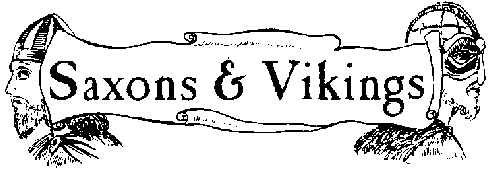
Derek Punchard
SAXONS COME TO STAY
ROMAN Maldon, known only through the fragmentary evidence of recent archaeological excavation, was to vanish from history for many centuries, leaving no trace on the written page or in the soil. It was not until the tenth century that Maldon was to re-emerge, this time in dramatic circumstances. The reason for this 'Dark Age' is due to a change from the organised, industrialised, 'Roman' way of life to a more insular rural existence which left very little evidence for archaeologists to find. If we consider the general British situation there was no sudden collapse, only a remorseless decline. Saxons were hired as mercenaries originally to fight the enemies from the north, the Picts and the Scots. They were to prove unreliable allies. Initially Rome did not consider Britain irrevocably lost nor did the Britons themselves assume that there would be no salvation from belligerent heathen tribes. It was not, perhaps, until 446 that the Britons realised that the end had come. A last desperate appeal was made to Rome. It was rejected.
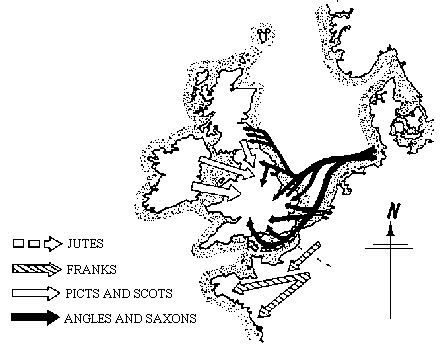
Once established, the invading tribes gradually transformed themselves from marauding bands and occasional confederates to conquerors. Tradition assigns this change to the year 449 and its cause to the invitation of the British king, Vortigern, to Angles to settle on the Isle of Thanet in return for their help against his enemies. The Anglo-Saxon Chronicle names their leaders as Hengist and Horsa and goes on to state that a combination of excellent land and supine Britons decided them to issue an open invitation to all and sundry. And so there followed a flood of Germanic invaders, later to be identified, perhaps too precisely and neatly by Bede, the eighth century monk and scholar, as Angles, Saxons and Jutes. They settled in the south and east of the country. Hengist and Horsa defeated Vortigern and Kent fell to the invaders.
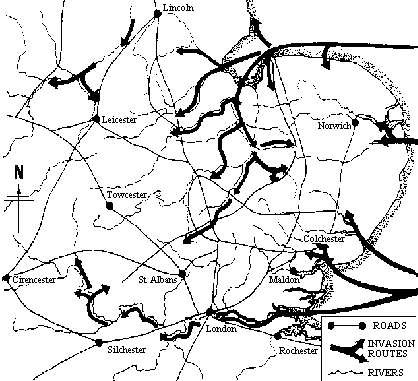
It is not thought that the change was as dramatic nor as precisely dateable as the Anglo-Saxon Chronicle suggests. There is no evidence of wholesale destruction and it is likely that Romano-British life continued, although in an increasingly attenuated fashion, for many years.
Isolated villas decayed as the owners sought refuge in towns that increasingly became important for the defence they afforded rather than as centres of economic activity. Although very little is known with certainty about these years, the general picture of a gradual Saxon advance and settlement westward during the late 5th century is well established. That there was fierce resistance is also certain. Ambrosius Aurelianus born, according to Gildas, the British ecclesiastic writing in the 6th Century, with imperial Roman blood in his veins, rallied the Romano-British forces and delivered a check to the Saxons. Gildas also mentions a great victory over the Saxons at Mount Badon. The victor of Mount Badon is unnamed by Gildas.
In the Welsh Annals it is recorded, 'Mount Badon, in which Arthur carried the cross of Our Lord Jesus Christ three days and three nights on his shoulders.' A later entry states 'The strife of Camlann in which Arthur and Medraut perished'. Nennius, a ninth century Welsh writer, attributes twelve victories against the Saxons to Arthur culminating in the battle at Mount Badon. There is little doubt about the historical existence of Arthur but far more vital has been the enduring legends created, in written form, by the 12th century imagination of Geoffrey of Monmouth and a French poet, Chretien de Troyes, whose colourful stories of King Arthur and the Round Table entertained the courts of France.
The legend was sustained in the 15th century by Malory's 'Morte d'Arthur' and, more recently, by Tennyson's 'Idyll of the Kings'. The shadowy figure of Arthur retains its potency and appeal today, fuelling the search for the legendary Camelot and, for a brief moment, endowing John Kennedy's presidency with dreams beyond political reality. The valiant deeds of Ambrosius and Arthur appear to have checked the advance of the Saxons in the first half of the 6th century. Thereafter a series of Saxon victories left the Britons with only a tenuous hold on the outlying parts of the land in Wales, the south west and north west. In the course of the 6th century various Saxon warlords established a number of petty kingdoms. Boundaries were fluid and there was constant warfare as these warlords attempted to expand or defend their power.
From these struggles later emerged what was described in the sixteenth century as the 'Heptarchy' or seven main Kingdoms - Northumbria, Mercia, East Anglia, Essex, Wessex, Sussex and Kent. Frequently one of the Kings possessed sufficient power to enable him to exercise overlordship over all kingdoms south of the Humber. Possibly the earliest ones were Aelle of the South Saxons (Sussex), Ceawlin of the West Saxons (Wessex) and Aethelbert of Kent. It is likely that Aethelbert in the late 6th century merged the East Saxon kingdom (Essex) with his own.
Much remains obscure. Written sources only throw a diffuse and uncertain light on Britain in the fifth and sixth centuries. It is not surprising, therefore, that such sources reveal little of the development of the East Saxon Kingdom. Of Maldon and its origins nothing is known. Archaeological research, operating within the known framework, has given some substance to what has hitherto been speculation.
Excavations at a number of sites indicate that Saxon settlement in Essex had begun by the end of the 4th century. The first inhabitants were, in all likelihood, foedarati. The largest early Saxon site so far discovered is at Mucking near Tilbury. Evidence of sunken huts and pottery, both typical of the early Saxon period were found. It is probable that Mucking was initially a military establishment designed to protect London.
Early Saxon sites within the immediate vicinity of Maldon have been discovered at the Roman port of Heybridge, at Tolleshunt d'Arcy and at Chigborough where early Saxon spindle whorls and loom weights have been found as well as later Saxon metal working.
Of the four timber wells found during the excavation of a gravel pit at Slough House Farm near Maldon, one was Bronze Age and the other three were thought to be Roman. However, when samples of the wood from two of the wells were sent for tree ring dating it was found that the wood of one had been felled in the early 6th century and the other in the early 7th century. These two wells are considered to be two of the best preserved early Saxon wells in England. The Saxon settlement that would have existed on the site has not been excavated.
Cemetery finds also indicate quite extensive Saxon settlement. The large early Saxon pagan cemetery at Mucking yielded body silhouettes but no skeletons. A variety of grave goods were found including military belt fittings, brooches, beads and pottery.
Early Saxon cemetery sites nearer Maldon have been discovered at Kelvedon and Broomfield. The most notable later Saxon settlement to have been found is at Wicken Bonhunt in the north west of the county. The archaeological evidence suggests it to have been well planned and organised.
Place names also indicate Saxon settlement such as those with the suffixes -ing (by a stream), -don (hill), -ford, and suffixes meaning a village as in -ham and -ton. Although the Saxons were incapable, at first, of sustaining urban life, the conclusion to be drawn from the evidence so far, suggests that the Roman towns of Essex, notably Colchester, continued to enjoy a degree of prosperity co-existing with Saxon settlement some years into the 5th century. It is likely that Colchester finally collapsed as a Roman town about the middle of the century and that this may well have coincided with the influx of the invaders alluded to by the Anglo-Saxon Chronicle, Gildas and Bede. In contrast to Colchester, which was to develop into an important Saxon town, Saxon settlement in Heybridge appears to have ended by the early 5th century.
THE CONVERSION OF THE ENGLISH PEOPLE
The collapse of Roman and Christian Britain under the weight of the pagan hordes from northern Europe had isolated Britain from the major developments on the continent. Although the Roman Empire had collapsed before the onslaught of barbarian tribes, Christianity, the religion of the Empire since the Emperor Constantine's decree in 313, survived.
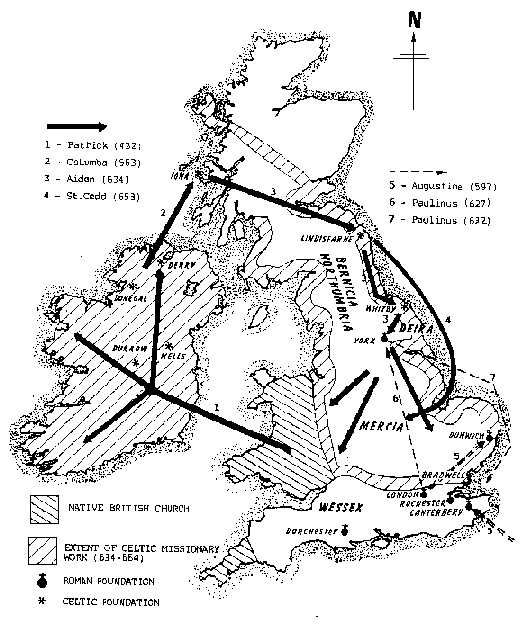
Eventually the Roman Empire split in two. The Eastern Empire, with Constantinople as its capital, held back the barbarians. In the West, the collapse of the Empire and the end of the Roman imperial line left only the Roman Christian church to preserve what it could of the imperial tradition. There the bishop of Rome emerged as Pope of the Catholic Church.
In 590 Gregory who had retired from an active political life to become a Benedictine monk, was dragged from the tranquillity of his monastic existence to become pope. Despite his reluctance, he was destined to become one of the great popes and in 596 took a decision which was to have a profound impact on England. The well known tale is told that, years earlier, as a monk he had seen some children being sold as slaves in Rome and when being told that they were Angles he replied, 'Not Angles but angels'. Gregory ordered Augustine from his own monastery to lead a mission to England to convert the heathen peoples there. Augustine and his companions were not at all enthusiastic about the prospect. However, they had one important stroke of luck. King Aethelbert of Kent had married Bertha, a daughter of the King of the Franks. Both he and his daughter were Christians.
Sensibly Augustine made for Aethelbert's kingdom, arriving in 597. Aethelbert, in common with his fellow Saxons, worshipped their ancient, pagan gods such as Tiw, Woden, and Thor whose names are still preserved in the days of our week. Aethelbert allowed the Christians to land on the isle of Thanet but he was careful to meet them in the open air where their magic would be much diluted. Eventually, he allowed them to live in his royal town of Canterbury where a Christian church still survived and was used by the queen. Success attended Augustine's ministry for it was not long before Aethelbert was converted and Kent became a Christian Kingdom. Pope Gregory made Augustine an archbishop and thus he became the first archbishop of Canterbury.
In 601 Gregory sent further instructions and reinforcements including Mellitus and Paulinus. Mellitus took Christianity to the East Saxons. Their king, Saeberht, was converted and a bishopric was established for Mellitus in his capital, London.
Success, however, was limited to Kent and Essex. King Raedwald, King of the East Angles, accepted baptism but hedged his bets by building a temple with half for the old gods and the other half for the new Christian God. This was the great age of the Kingdom of the East Angles and its rich court was exemplified by the magnificent treasure discovered beneath a series of low grassy mounds rising out of a wide sandy expanse of land above the River Deben at Sutton Hoo near Woodbridge.
After the deaths of Aethelbert and Saeberht in 616, Kent and Essex reverted to paganism although Kent quickly returned to the faith. Mellitus was driven from London and left the country but was to return shortly afterwards to become the third archbishop of Canterbury. Bede recounts the tale of Mellitus, crippled by gout, being carried into the path of flames that were consuming Canterbury and, by his steadfast faith and prayers, causing the wind to change direction and the fire to die out. A statue of Mellitus occupies a niche in the south wall of All Saints' Church. Appropriately, for one whose feet were afflicted by gout, the saint is depicted in a sitting position.
Canterbury was not the only centre of missionary work. In 432, St. Patrick was sent by Pope Clement to Ireland and, by the time of Patrick's death, Ireland was a Christian country. Many became monks. They lived lives of great simplicity and discipline and, with their intense love of learning, they became the best educated men in Europe and from their humble monasteries came the most exquisitely illuminated manuscripts such as the Book of Kells.
About a century after the death of St. Patrick, the Irish monks began to wander, preaching their faith to all they encountered. One such monk was Columba who founded a monastery at Iona in 565 before setting out to convert the Picts. In 635 Lindisfarne was founded with Aidan as its first bishop. Aidan's success was spectacular and it is said that the land seemed to contain more monks than warriors. Supported by King Oswui of Northumbria, Lindisfarne extended Christianity southwards. The East Saxons returned to Christianity after Bishop Finnan, Aidan's successor had baptised King Sigeberht the Good in 653. Sigebehrt begged Oswiu to send him missionaries. Cedd was sent to preach and baptise. He was made bishop of the East Saxons. He worked with great vigour and success, building many churches. Bede mentions his two centres as Tilbury or Tilaburg and Ythancaster identified as Bradwell on Sea. He attended the Whitby Synod of 664 but shortly afterwards caught the plague and died.
|
By 660 all England except Sussex and the Isle of Wight were, at least, nominally Christian. For some time, apostasy was not far below the surface. When plague spread to the East Saxons after the death of Cedd, the Kingdom was divided between Sighere and Sebbe. Sighere's portion lapsed into idolatry. Wulfere, King of Mercia and overlord of the East Saxon kings, sent Bishop Jaruman of Mercia to recall the people to their faith. Cedd was succeeded by Wine who, having been thrown out of Winchester, bought for himself the bishopric of London from Wulfher, King of Mercia. |
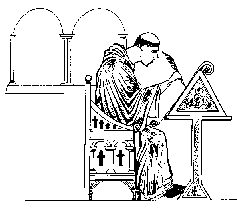
|
Despite the Christianisation of almost all of England there was no national church. Practices varied noticeably between the Celtic and the Roman churches. In particular the date of Easter differed. This was brought home to Oswiu after he married Eanflaed, the daughter of King Edwin, a former king of Northumbria. Eanflaed had been brought up according to Roman custom. Hence they found themselves celebrating Easter at different times. To resolve all problems, Oswiu convened a conference of bishops and clergy at Whitby in 664. When Wilfred, abbot of Ripon, spoke of the popes as holding the keys of heaven from St. Peter, Oswiu professed himself anxious to ensure that at the gates of heaven, St. Peter would let him in. That settled the matter and the English church became Roman.
FROM OFFA TO ALFRED
The century after 600 saw the emergence of three dominant kingdoms, Northumbria, Mercia and Wessex. The smaller kingdoms either maintained a precarious independence or were absorbed by one of the larger ones. By the later 7th century Northumbria's political and military supremacy during the reigns of Edwin, Oswald and Oswui, was over. The glory of its learning, literature and art continued, however, into the 8th century.
Its greatest scholar was the Venerable Bede whose 'History of the English Church and People' justly earned him the title of 'father of English history'. Much that is known of the early Anglo-Saxon period is derived from his pen. Although the motive behind his writings was to teach men to avoid evil and to follow what is pleasing to God, his concern with accuracy and his careful scrutiny of his sources has earned him the respect of historians who do not share his motivation or his acceptance of the veracity of miracles and portents. Although travelling no further from Jarrow than Lindisfarne and York, his writings became famous throughout Europe and scribes were hard pressed to keep up with the demand for them.
|
Political power shifted to Mercia. Penda defeated the West Saxons in 628 and extended Mercian territory southward to the lower reaches of the River Severn. In 653 he placed his son in control of the Middle Angles whose territory stretched to the borders of East Anglia and Essex. East Anglia shortly afterwards came under his direct control. His son, Wulfhere, became overlord of the East Saxons and gained control of London. He became overlord of Surrey and seized West Saxon territory on both sides of the Upper Thames although with the emergence of the strong West Saxon kings, Ceadwalla and Ine, the land south of the Thames was soon lost.
After two weak kings of Mercia, the formidable Ethelbald came to the throne in 717. He subjected all land south of the Humber to his rule including, therefore, London and Essex. Wessex acknowledged his overlordship. His 40 year reign was ended with his murder in 757 but he was soon followed by the greatest of all Mercian kings, Offa. |
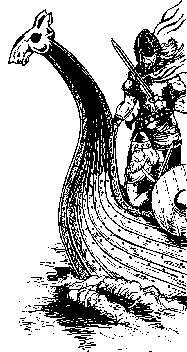
|
Offa had no need to interfere in Northumbria for it was in the hands of a respectful son-in-law but elsewhere he asserted his dominance such as no other king had done so before and he became a ruler to be reckoned with on the continent. His most enduring monument is the dyke which bears his name. Whether boundary marker between the Welsh and the English or defensive earthwork, it represents an astonishing engineering achievement which could only have been accomplished by a powerful and impressive ruler. It is with justice that Alcuin, Archbishop of York, referred to him as 'king and glory of Britain'.
In the last decade of the century Alcuin wrote with foreboding of the trial England was to endure during the next one hundred years. "Lo, it is nearly three hundred and fifty years that we and our forefathers have inhabited this lovely land, and never before has such terror appeared in Britain as we have suffered from a pagan race, nor was it thought that such an inroad from the sea could be made."
The Anglo Saxon Chronicle records for 793, "In this year terrible portents appeared in Northumbria, and miserably afflicted the inhabitants; these were exceptional flashes of lightning, and fiery dragons were seen flying in the air. A great famine soon followed these signs; and a little while after in the same year the harrying of the heathen miserably destroyed God's church in Lindisfarne by rapine and slaughter."
There had been a warning of what was to come four years earlier recorded in one of the Chronicles, "And in his days came for the first time three ships; and then the reeve rode thither and tried to compel them to go to the royal manor, for he did not know what they were, and they slew him." Alcuin could only attribute this terrible visitation to God's wrath against the sinful Northumbrians.
As the 8th century dawned, the events of 793 might have seemed an isolated occurrence. England suffered no further raids until the 830's. Instead the Vikings concentrated their plundering attacks on islands around the coast. In 802 Iona was sacked and this was followed by raids and settlements on the Hebrides, Orkneys and Shetlands. Ireland suffered most for it offered easy and rich pickings. The first raid was in 795 and was followed by colonisation. In 836 Thorgils had set himself up as a king.
By this time, however, it was England's turn.
The Vikings were faced with a rich and poorly unified country. No great and powerful king such as Offa had emerged. The kingdom of Wessex had become, however, a rival to Mercian supremacy and Essex came under its rule. During the 9th century, the Vikings were to destroy all the English kingdoms except Wessex and thus indirectly paved the way for Wessex supremacy.
The recent emphasis on Viking creativity and heroic deeds of exploration to Iceland, Greenland and, most spectacularly, to Vinland or Newfoundland cannot detract from the shock of their savage eruption over large areas of Europe. In their superbly fashioned longships they sailed west to England, south to France and the Mediterranean and east down the great rivers of Russia. Everywhere they left their mark but in England they conquered and in France they founded the future Duchy of Normandy.
The reason for this sudden and violent expansion of Viking activity has been variously attributed to population pressure on limited resources, on political changes which led nobles to seek their fortune elsewhere and on Viking reaction to the the expansion of Charlemagne's empire. Perhaps the simplest explanation is the most plausible. Many of the Vikings were seafarers dependent, therefore, on their ships. Just prior to the period of Viking expansion, developments in their ship building produced a vessel capable of successfully carrying a crew of thirty or more over long distances. This combined with the fact that contact with many of the lands they visited convinced them that raiding rather than trading would prove easier and more profitable might well be the simple explanation for their wide ranging exploits in the 9th century.

Whatever the cause, the effect was to be felt by the English from the 830's onwards. In 834 Sheppey was attacked. In 835 King Egbert of Wessex was defeated but the following year he put to flight a combined Danish and British army. Further raids occurred in 841, 842, 843 and 844.
Then the Viking raiders started the practice of wintering on convenient island bases in river mouths ready to launch attacks as soon as spring arrived. In 851, after wintering on the isle of Thanet, an army from 350 ships attacked Canterbury and London and put King Beorhtwulf of Mercia to flight but was then defeated in turn by King Aethelwulf of Wessex. The Anglo Saxon Chronicle records only one attack during this period on an area outside Wessex but it is likely that this reflected its concern principally with the affairs of that kingdom rather than an absence of attacks elsewhere. The east coast would certainly have been extremely vulnerable and tempting.
There was a short lull when the Vikings were preoccupied with events on the continent but in 865 the threat became even more serious. A Danish army devastated the eastern part of Kent. In the same year the largest army yet,led by two notable Viking warriors, Halfdan and Ivar the Boneless, camped in East Anglia without being resisted. Conquest rather than plunder was clearly the intention. This army moved into Northumbria captured York and then killed two rivals for the throne of Northumbria. A puppet king was placed on the throne. The Danish army then moved into Mercia. King Burgred of Mercia appealed for help from his brother in law, King Aethelred of Wessex who led an army in the company of his brother Alfred to besiege the Danes in Nottingham. Eventually the Danes withdrew to York. In 869 they moved back to East Anglia and the following year defeated and killed King Edmund.
In 870 Halfdan struck at Wessex. After an initial victory at Ashdown, King Aethelred suffered defeat at Basing and Marlborough. Aethelred's death in 871 brought England's most famous king to the throne. Already he had proved himself a daring soldier. It is said that, at the Battle of Ashdown, Alfred launched an attack on the Danes whilst his brother and king was at prayers and that this attack was largely responsible for the victory. Few kings have received such a daunting baptism. According to the Anglo Saxon Chronicle nine battles against the Danes were fought that year. Such unprecedented resistance in Western Europe against the Danes led to a temporary end of hostilities but Alfred had to pay a price in money, payment which was to become traditionally known as danegeld. The Danes retired to London and turned on easier foe. King Burgred was driven into exile and a client king put in his place. Halfdan then took half of the army into Northumbria and, after the inevitable ravaging, settled his men in an area now represented by Yorkshire.
Another army under Guthrum made a further attempt to destroy Wessex, now the only kingdom not under Danish control. Guthrum occupied Wareham as a base for attack. Alfred offered gold again which the Danes took but carried on with their attacks.
However, the destruction of a Danish fleet by a storm decided Guthrum to make peace and he retired to Mercian town of Gloucester. It seemed that Wessex had been saved. In fact the worst was to come.
In 878, Guthrum from his headquarters in Gloucester, made a sudden attack in the middle of winter on Alfred's headquarters at Chippenham at a time when the Wessex army was stood down, and took him by surprise. He was forced to seek refuge in the marshes around Athelney in Somerset. In such circumstances he might well have abandoned the fight and, like King Burgred of Mercia, gone into exile. Alfred was made of sterner stuff. He adopted the Viking practice of constructing a burh which was an area protected by a defensive earthwork. From his stronghold he conducted a guerilla campaign.
The strong bond forged between dynasty and people was demonstrated by the fact that his people rallied to him. He summoned the levies of Somerset, Wiltshire and Hamphire to meet at a place known as Egbert's Stone. Two days later he fought the decisive battle of Edington which led to the surrender of the Danes. Guthrum promised to leave Wessex and he and thirty of his leading men were baptised. The Danes, not known for honouring their pledges, did so this time and moved back to East Anglia.
During the subsequent few years' respite from attack Alfred put his kingdom in good defensive order, building a strong navy, constructing a series of burhs and, to meet the need for permanent military preparedness, Alfred divided his levies into two, half going about their normal business in towns and in the fields. This did not always work as shown on one occasion when a besieged Danish army was able to escape when the Wessex soldiers on duty left before those due to relieve them arrived.
The worst of the danger was clearly over but the Danes were still active. New invaders besieged Rochester in 885 and Guthrum was tempted to help them. A fleet sent by Alfred was badly mauled. These events determined Alfred to take the offensive and in 886 London was captured. Alfred at some subsequent date made a more definite peace with Guthrum. A treaty established the boundaries between the areas controlled by Wessex and the Danes. This boundary went up the Thames to the mouth of the River Lea, along the Lea, then to Bedford, the Ouse and finally along the line of Watling Street. To the east of this boundary Danish supremacy and its law, Danelaw, was recognised. Essex, and, therefore, Maldon fell within this area.
Events on the continent where the Vikings were very active affected England. Guthrum had died in 891 and so any peace with Alfred now lapsed. Defeat in France encouraged a Viking force to seek better fortune in England in 892 and sailed up the Thames and camped in Kent. Another force also arrived in Kent. Such activity stimulated the Danes of Northumbria and East Anglia into activity. Most of the military activity took place in Kent and on the Essex shore of the Thames. The Danes, attempting to return to their fortress base at Benfleet, were intercepted and defeated by Alfred's son, Edward. Shortly afterwards an English army stormed the fort at Benfleet. When the railway was built in the 19th century skeletons and charred remains of ships were discovered on the site. The Danes then moved further down the river to Shoebury. No confrontation was decisive, in part because Alfred had to deal also with attacks on Exeter from the sea by Northumbrian and East Anglian Danes.
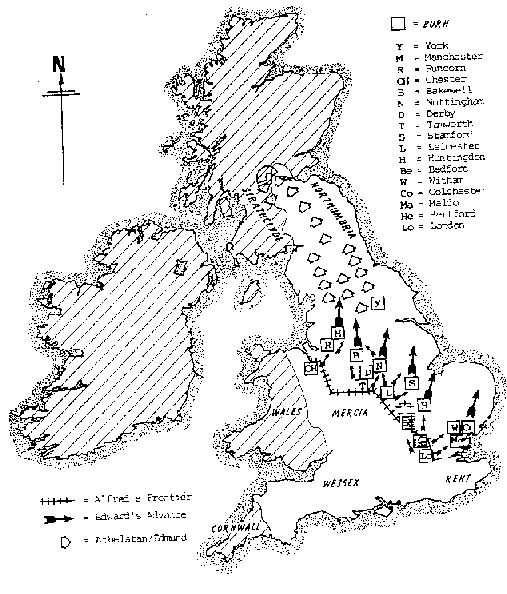
From Shoebury the Danes struck into the heart of England along the Thames and Severn. A force led by Earldorman Aethelred of Mercia pursued and defeated them but was unable to prevent many of them escaping back to Essex. The Danes then fell back to the greater safety of East Anglia. They then marched quickly northward to encamp in the fortress of Chester. Harassed by the English they moved off on a plundering march through Wales and then returned to East Anglia. A camp was established at East Mersea but was soon abandoned. Instead a fortified camp was built on the River Lea above London. Alfred forced the Danes to abandon it in 895.
Despite some damaging raids by the Danes all real threat had disappeared. Had Alfred's exploits been limited to those on the battlefield this would have been enough to have established his reputation as a great king. Yet despite most of his life being spent in battle, he devoted himself to the future well being of his kingdom. He believed the education of his people was essential and his commitment was demonstrated by his decision at the age of thirty eight to learn to read and write.The Danes had destroyed so many monasteries that Alfred feared that the Christian basis of English civilisation might be lost. He invited churchmen and scholars, particularly from Mercia, to his court. Under his direction the riches of Christian literature were translated, including Bede's History, into the vernacular and distributed throughout the kingdom. Above all, he was probably responsible for the unique and incomparable record of the royal House of Wessex which is enshrined in the Anglo Saxon Chronicles without which large portions of even this brief record could not have been written.
Alfred left one more legacy to England, a son who was worthy of his father.
THE MALDON BURH
The fury of the Viking assault had largely been spent. The Danes were more inclined to settle down to peaceful pursuits. Their unity, never particularly prominent, became fragmented whereas that of the rest of England was strengthened under the House of Wessex. Nevertheless the reconquest of the Danelaw was no easy task and was to take thirty years to accomplish. It also required military leaders of genius. Fortunately in Edward and his successor, Athelstan, England possessed such leaders. Edward proceeded to recover Essex, East Anglia and the Midlands from Danish control.
In 912 Edward built forts at Hertford to protect him from the north while he moved against the Danes in Essex. The Anglo Saxon chronicle states that,"....King Edward went with part of his forces to Maldon in Essex, and encamped there whilst the earthwork at Witham was being built and stockaded: and a good number of people who had earlier been under Danish domination submitted to him".
The burh at Witham stood on the route from Colchester and London and effectively protected the latter from Danish attack. Maldon thus enters written history for the first time. The event is further recorded by Henry of Huntingdon writing in the 12th century but he adds nothing to the account in the Anglo Saxon Chronicle.
Maldon obviously predated Edward's arrival but there is no evidence to indicate the time span involved. Writing of the years following 500AD, Fitch in his 'Guide to Maldon and the River Blackwater' confidently asserts that "For the next three centuries Maldon, in common with the new tribal home, was growing in importance, but the seat of military defence having been removed from the mouth of the estuary, left it more open to attack from the sea. During the short interval of peace, it probably developed into an important port, as we know it possessed its own mint, and had received, like the greater part of the country, its present distinctive name Maeldune, the hill at the cross roads, or the cross on the hill".
The evidence clearly corroborates the general belief that town life after 410AD, even if it did not suddenly collapse, showed a steady decline after the advent of the Saxons and did not begin to revive until the 8th century. The Saxons, furthermore, tended to settle in the low lying areas near to their points of entry and their ships and may well at first have avoided the hill on which Maldon stands. In any case Heybridge, as a small Roman port, already existed and it would be unlikely that an alternative site so near would have been developed. Coinage too deteriorated along with town life and was not to revive until much later. There is certainly no evidence of a mint until the 10th century. Similarly all the archaeological evidence is restricted to the late Saxon period. Archaeological excavation of the the site of 62-64 High Street, opposite St. Peter's Church tower, yielded evidence of continuous occupation of the site from the 10th century at the latest. Traces of a late Saxon Hall and a great deal of St Neot's pottery and two sherds of Stamford pottery were discovered on the site. Generally, in view of Maldon's importance as a Saxon and early medieval town, a disappointing lack of archaeological evidence has been forthcoming.
After making further progress against the Danes and defeating a Viking raiding force from Brittany, Edward was back at Maldon in 916. Again the Anglo Saxon Chronicle records the event, "In this year, before midsummer, King Edward went to Maldon and built the fortress there and garrisoned it before he left".
There is, therefore, no doubt that a burh was built in Maldon. The presence of a mint confirms it, since mints were only established in burh towns. What, however, has exercised the minds of those interested in Maldon's past is the exact site of Edward's burh. It is, by tradition, assumed to be in the area bounded by Spital Road, Gate Street, Beeleigh Road and Lodge Road/Dykes Chase. Logic supports this supposition since the area is on high ground overlooking the river, an excellent place for a burh. The writings of antiquarians of the 18th century who record details of the burh have been perused for clues as to the position of the site.
The first description of the burh is contained in 'The History and Antiquities of Essex' by N. Salmon and published in 1740. Salmon records that, "There are the remains of a camp on the west side of the town, through the middle of which the road to Chelmsford goes: three sides of the fortification are visible. The ground within the vallum (earthwork) seems to be of about twenty two acres. Just without it, on the north side is a fine spring, which improved the situation. We see three sides of a square or oblong, the rest being built upon and defaced. This has a fair pretence to be Roman; but as Edward the Elder encamped here, it is not certain whether he fortified it or not or found it ready done to his hands".
The Reverend Philip Morant in his 'The History and Antiquities of the County of Essex' published in 1768 confirms the observations of Salmon in almost identical words. "O n the west side of this town are the remains of a camp, through the middle of which is the road to Chelmsford. Three sides of the fortification are visible, being a square or oblong inclosing about 22 acres, the rest is built upon or defaced. Just without it on the north side, is a fine spring, which improved the situation. Whether this is a Roman, Saxon or Danish work, I am unable to determine" .
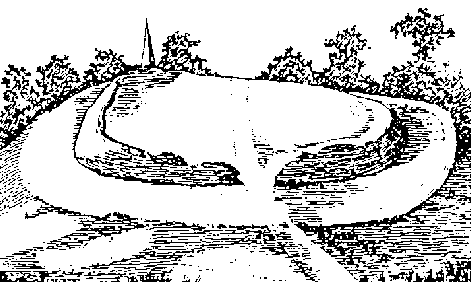
In 1775 the only illustration of the burh appeared in Joseph Strutt's 'Complete View of the Manners and Customs etc.'. This cannot be an accurate representation of what Strutt saw since there is no evidence of the defacement or buildings of which Salmon writes. Instead Strutt has removed all obstacles which has ensured that the exact site of the burh cannot be deduced from his drawings. There are only two clues, the road to Chelmsford (London Road) is clearly shown and in the distance appears the spire of All Saints' Church.
On the basis of these clues most people have assumed that Strutt's view was taken from the top of Cemetery Hill. There is, however, a discrepancy between Strutt and Salmon as far as dimensions are concerned. Strutt gives the dimensions of A or the Vallum as 220 x 290 yards. Salmon's assessment of 22 acres is much larger.
The spring mentioned is, without doubt, Cromwell Well which can still be seen in a garden on the north side of Beeleigh Road. This was to be the source of the water supply provided by Thomas Cammock in the 16th century to the pump on Cromwell Hill.
There is silence about the burh until Fitch published his guide at the end of the 19th century. By this time the development of the western part of the town had largely destroyed all traces of the burh as indicated by Fitch, "The site of this Saxon camp at Maldon can still be faintly traced at the west end of the London road, overlooking Wintersleet Hill towards Danbury, and I have an old sepia sketch shewing the ramparts quite distinctly, with the spire of All Saints' Church in the distance".
In 1906 I. Chalkley Gould read a paper at Maldon entitled 'The Burh at Maldon' which was subsequently published in 'Transactions of the Essex Archaeological Society' Vol.X. He confirmed the almost total destruction of the burh with the exception of a fragment at the north west angle. He ended his paper with a plea '....for the preservation of this fragment as a memorial of one of the most eventful periods of England's history.' Sadly the plea went disregarded and today it is hard to detect even this north west angle with any certainty.
A few random observations provided some information which, in isolation, meant very little but in the context of other evidence became more significant. It was noted that the foundations of the rear garden wall of 5, Gate Street were exceptionally deep and wide suggesting large scale soil disturbance consistent with the existence of a large ditch which had been infilled. The persistent cracking of a Victorian wall flanking London road and belonging to West House might well be indicative of inadequate foundations in a place where soil disturbance was unusually great.
No further work was done on the location of the burh until the formation of the Maldon Archaeological Group in 1977. It launched an appeal for help in researching the burh. Several people living in the assumed area of the burh enthusiastically volunteered information and assistance but nothing conclusive emerged at the time. A topographical survey of the area might well be informative. Although a start was made to this, it has yet to be completed. Excavations in the area have, with one exception, provided only negative evidence. The opportunity for extensive excavation is limited in such a built up area although householders who are prepared to see their gardens dug up in the pursuit of knowledge are not as rare as one might expect. Occasionally, building or rebuilding provides opportunities and two limited excavations were carried out on the south side of Beeleigh Road. No Saxon remains were discovered.
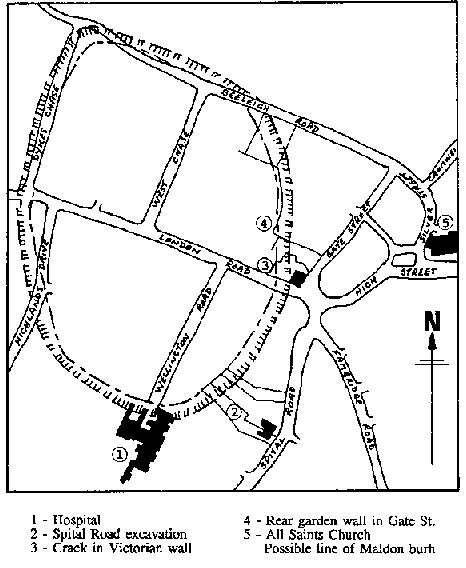
1983 brought a stroke of good fortune. When a property in Spital Road changed hands, the new owners were anxious to remodel the garden and obligingly offered Maldon Archaeological Group the chance to carry out an excavation. The area had always been a prime object of interest, not only because it fell within the supposed area of the burh but also because, at the rear of several gardens from near Gate Street to the site of St Peter's Hospital and, thereafter intermittently, to West Chase, runs a prominent bank of earth. A trench was dug on the site and clearly revealed a large ditch some 8 metres wide and 2 metres deep. A small Early Iron Age (circa 600BC) pit or post-hole was the earliest feature excavated. Stratification of the soils in the Spital Road trench revealed a sequence of ditches of varying sizes adjacent to the surviving earth bank. Early pottery sherds were found alongside Medieval sherds in the widest of the ditch cuts. Although this could not be securely dated, Late Saxon or Early Medieval origin are the most likely. However, it was clear from the stratification that this part of the ditch remained a prominent feature until the 19th century when it was obliterated, perhaps by the dumping of soil occasioned by the construction of a new Work House in 1873 (now St. Peter's Hospital).
One needed to stand on the top of the bank looking down into the trench to appreciate that the earthwork would have presented a formidable obstacle, particularly when surmounted by a 6 foot wooden stockade. The evidence does point to the general accuracy of Strutt's diagram and the description of the burh which he observed over two hundred years ago. It can also be observed that the site afforded a fine view to the south for several miles as well as dominating the river on the north side. It could be that King Edward refortified what remained of an ancient Iron Age fort. The existence of earthworks and the strength of its position would have made this a sensible thing to do. It would be difficult to imagine Edward either ignoring the advantage of the existing earthworks or of finding an alternative site of equal merit. Nevertheless, whether the site is that of an Iron Age fort, later to be refortified by Edward, still remains an open question. Other sites for the Saxon burh have been suggested such as the area immediately to the east of the top of Market Hill and the area around St. Mary's. However, the London Road site remains the most convincing, despite the fact that there has been a complete absence of any late Anglo-Saxon finds in the area.
Some towns are known to have had more than one burh so this is also a possibility at Maldon. It would also have been normal to have expected the town to have developed within the safe confines of the burh defences as happened at Wallingford in Berkshire.Instead the town developed outside the London Road site until the 18th century. Whether the Saxons, for superstitious reasons, shunned an ancient pagan settlement except in times of danger, remains in the realm of speculation.
Wherever the burh was, it was soon to be put to the test as Edward continued his campaign to conquer the Danelaw.
THE MINT
|
Maldon's importance was confirmed by its possession of a mint, the establishment of which was dependent on the prior existence and protection of a burh as laid down by Aethelstan in the Statutes of Greatley. Until the mint at Colchester was established in 991, the Maldon mint was the only one in Essex. A mint, in the sense that it was meant in Anglo-Saxon and early medieval times, did not imply a permanent site, merely that a moneyer or moneyers could issue coins there. Moneyers operated in their own premises in much the same way as gold and silver smiths. There is no record of when the Maldon mint was established. |

|
The earliest coin known to exist from the mint is one from the reign of Aethelstan which is in the care of the Keeper of Antiquities at Rome. The obverse of this and subsequent coins shows the face of the monarch with an appropriate legend such as "Aedelraed rex Anglox". The reverse reveals not only the place of minting but also the name of the moneyer. On the evidence of the number of coins surviving Maldon was not an important mint before 991, apparently sharing a moneyer with the Hertford mint. The large mints such as that in London, catered mainly for the merchant community wishing to convert foreign coins into English ones.
During the reign of Aethelred, nine types of coin were struck in Maldon, most notably the crux or cross issue, the name deriving from the motif on the reverse. The Maldon mint had its moment of glory during the crux issue with several moneyers producing something like half a million coins over a period of six years. Colchester mint was established in 991 to cope with the demand for the crux issue and for a time fourteen moneyers were working there. Those who are able to examine such coins may well notice a small scar or groove incised in the surface of some of them. These are known as 'peck' marks and embue such coins with some of the drama of Aethelred's reign. Vikings had the habit of digging the point of their daggers into coins to assure themselves that they were of solid silver. It is possible that to see a Maldon 'peck' marked coin is to see a coin which formed part of a payment of Danegeld and even, perhaps, one might imagine that it was once handled by a Viking victorious at the Battle of Maldon.
After 997, activity at the Maldon mint quickly declined and it returned once more to its minor role. There has been no convincing explanation of the Maldon mint's spectacular burst of activity although it has always been assumed that it was associated with the payment of Danegeld in 991 and subsequently. However, there seems no reason why the Maldon and Colchester area should have borne the burden of this form of taxation unless it was remarkably wealthy. The most obvious place to produce such a vast quantity of coinage was London. Furthermore, it is doubtful whether the Danes were concerned about the form in which the silver came so turning it into coinage seems unnecessarily laborious.
The mint survived the Norman Conquest and was recorded in the Domesday Book. On the basis of published coin evidence we know that the mint continued in operation at least up to the reign of William the Conqueror's son, William Rufus (1087 - 1100).
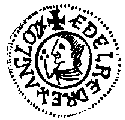
|
Maldon Minted Coin
CRVX |
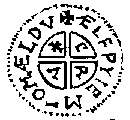
|
| Mealdune Contents | Maldon Archaeological Reports Home | Next section..... |